FL2100 Yaesu Oscillation
FL2100 Yaesu Amplifier Modifications
Relay Control Voltage
With any old amplifier, check the relay line voltages and
currents before connecting to a modern rig. Relay line voltages never were
standardized.
The FL2100 series is a good example. Early units, the FL2100 and
2100B, used a negative 15-18 volts relay voltage. This line spikes to nearly
-100 volts on relay opening. Also if the tubes arc the relay line can dump 2000
volts out to whatever is connected. It is not a good relay and bias system at
all, especially in light of the fact many new 572B
tubes have contamination and arcing problems.
The later FL2100Z is positive low voltage, but has other relay
line issues that are detailed below.
Improper Tuning
It is important the FL2100 be tuned as well as possible because
it really does hammer the tubes pretty hard.
Here are two graphs of anode dissipation and efficiency of a
FL21000 on 40 meters:
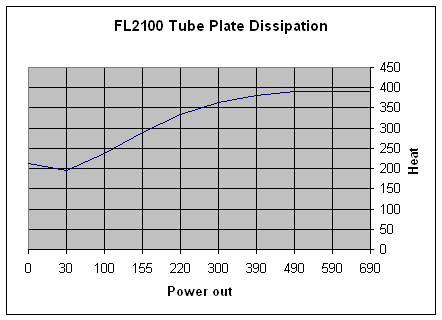
With the amplifier loaded for maximum power transfer at 500 mA plate current, I
obtained the data on the right by plotting meter readings as drive was reduced
to bring power output down.
Note how slowly heat drops compared to power.
Heat is for two tubes. The ICAS rating of two tubes is 320 watts dissipation.
The FL2100 has little headroom for mistuning or long carriers.
Based on my envelope temperature measurements about 500 to 800 watts (total for
two tubes) dissipation for one minute solid should melt the glass.
I
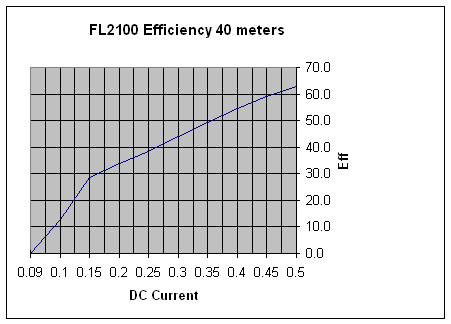
Heat drops so slowly because efficiency falls as drive power is
reduced. At about 125 mA plate current efficiency falls in nearly direct
proportion to power reduction, because the amplifier is nearly class A operation
at low power.
Reducing power does not extend duty cycle much unless the amp is
reloaded at lower power levels for high efficiency.
Oscillation or
Instability
The reason Svetlana tubes oscillate in the FL2100 is two-fold:
FL2100 Bias is inadequate for Svetlana tubes. Svetlana tubes have LOWER mu
(not higher as some people claim) and draw more current for a given amount of
bias.
- The FL2100 has
no neutralization
and is not stable
at HF under all
load conditions.
This is true with
any tube used in this
amplifier.
The FL2100Z was
revised in an
attempt to fix the
inherent stability
problems. The
FL2100Z:
- The
FL2100Z has an
improved (but
still unusual) bias system. -
The FL2100Z has a very poor attempt at neutralization or feedback.
Bias
design error
If you look at my
page on
amplifier cathode
bias,
you’ll notice the
best practice is to
let high mu tubes
float up to cutoff
bias by opening the
cathode return path
while the control
grid is either
grounded or biased
negative The FL2100 only applies ~15
to 18 volts
negative bias to the 572B grids for cutoff.
15 volts is not adequate for some 572B tubes, especially those with slightly lower mu,
like Svetlana tubes.
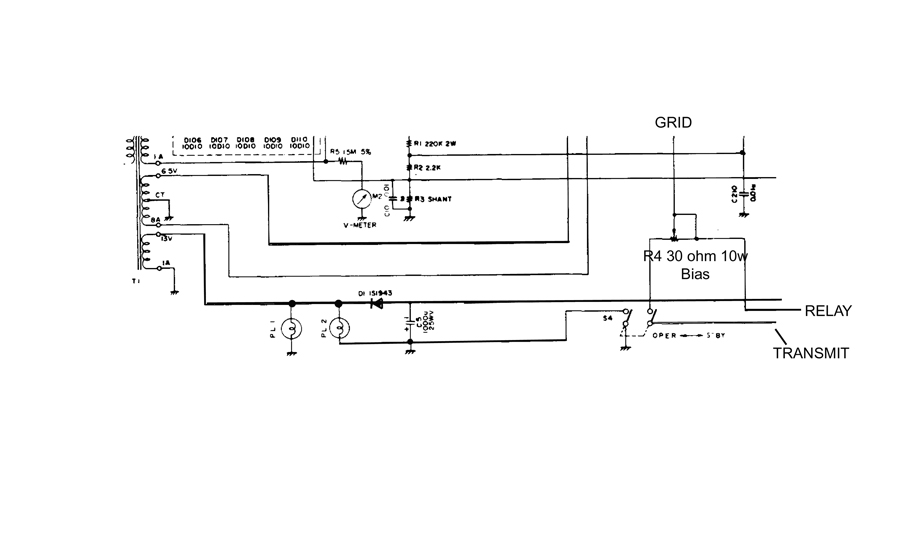
FL2100 bias
system
Operating bias is
developed by voltage
drop of relay coil
current through R4.
Standby bias voltage
is open circuit
voltage of T1, D1,
C5 negative supply
voltages, or about
-18 volts.
D1
anode goes to relay
coil
“Relay” is return
from relay coil
“Transmit” goes to
radio transmit
closure line
Relay control
voltage is
approximately 18
volts negative at
120 mA, with a short
~100 volt “kick”
upon opening.
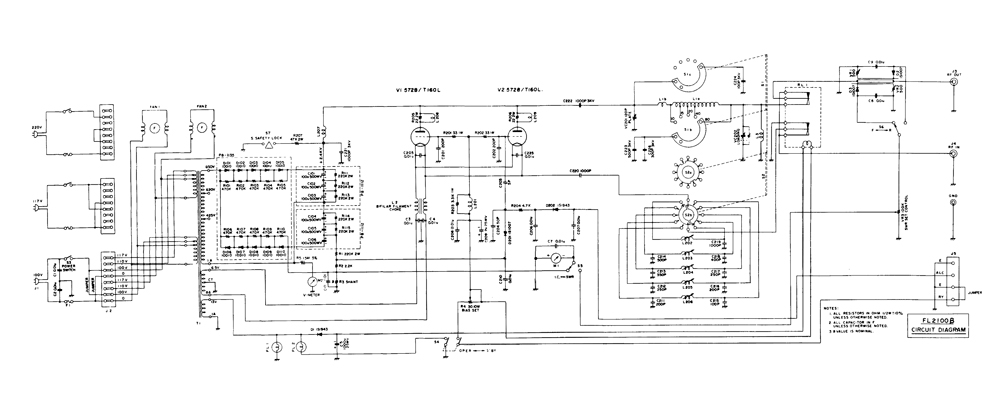
Yaesu learned standby bias
was not high enough
in the FL2100B.
Later versions of
the FL2100, the
FL2100Z, use a
voltage tripler in
the bias. While this
is a great
improvement the best
method is still to
let tubes seek their
own bias by opening
the cathode path.
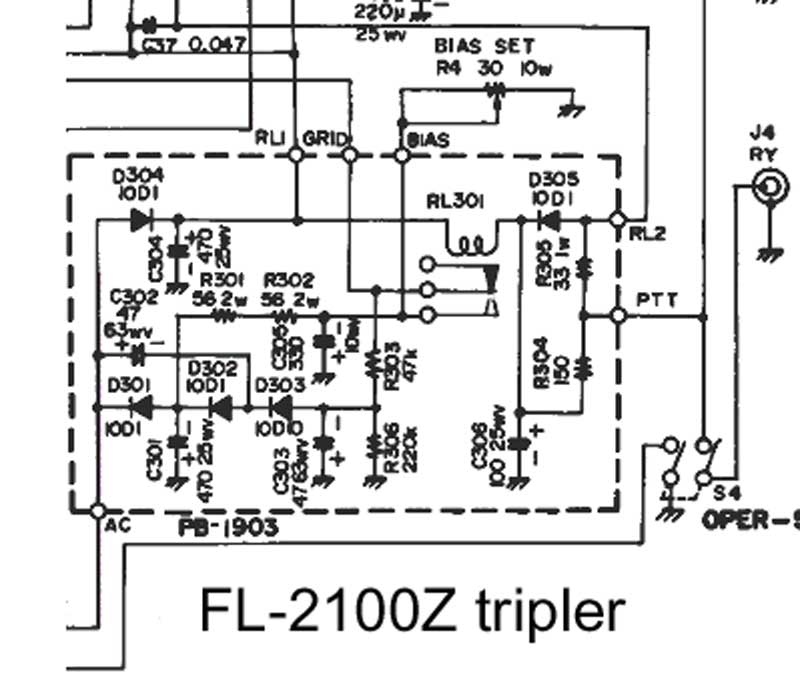
The FL2100Z has
an
overly-complicated
three voltage power
supply for control
and bias.
Cut-off bias
Diodes D301, 302,
and 303 along with
capacitors C301
through C301 form a
negative voltage
tripler for tube
bias. Approximately
-50 volts bias is
supplied through
R303. This is
adequate to cut off
any tube, regardless
of slightly lower
production mu.
Operating Bias
On transmit, a
divider consisting
of R301,302, and R4
is connected. R301
and 302 connect to a
“tap point” on the
tripler where -18
volts is available.
This divider
supplies the
operating bias. Bias
is slightly unstable
with grid current,
and decreases the IM
performance of the
FL2100Z.
Control Voltage
+18 volts is
supplied from D304.
D304 is a half-wave
rectifier filtered
by C304, supplying
positive “12 volts”
for the antenna
relay RL301.
Had cathode bias
been used, only one
supply would have
been required!
The FL2100Z also
hammers the radio
control line pretty
hard. It discharges
a 220uF capacitor
charged to +18V
through a 33 ohm
resistor, and a
100uF at +18V
through a 150 ohm
resistor into the
radio every time the
relays close.
Depending on other
resistances, the
surge current into
the control line can
be as high as 650 mA
on relay closure.
This can damage
small reed relays in
some radios in a
short amount of
time.
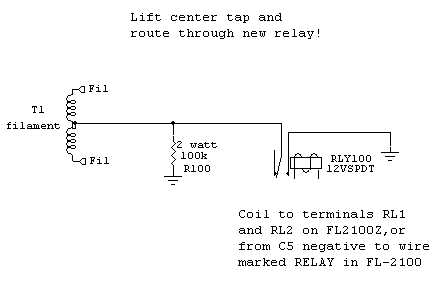
An inexpensive 12V
low current relay
corrects the bias
issue without
complicated circuit
or wiring changes.
This circuit is
normally not
required in the
FL2100Z, but it is
absolutely necessary
in the FL2100.
Feedback
Design Error
572b’s are not well-designed tubes for RF systems. They are more like audio
tubes in design. Click this 572B link and go to
stability.
The FL2100 design uses a capacitor from the OUTPUT of the pi network back to the
input of the tubes.
A good design would NEVER do
something like this.
A pi-network transforms phase along with load
impedance. As the
tuning and loading
controls are moved,
and as the antenna
load impedance
changes, the phase
of the feedback
voltage changes. The
output tuning and
loading as well as
the antenna
impedance greatly
affects feedback voltage.

A good design would never neutralize or add feedback from the OUTPUT of a tank
circuit with a varying load back to the input.
This is because the
load impedance as
well as the setting
of the plate and
load capacitors will
vary feedback phase!
Feedback phase
should be a stable
180-degrees, but in
this case it can
range from -80 to
-150 degrees
depending on band
and pi-network
control adjustments.
Effect of
Yaesu FL2100 design
errors
When the antenna relay open, the LOAD is removed from the pi-network. This
INCREASES the amount of feedback by several times. The tubes, having less mu and
requiring more bias, are no longer in cutoff with the relay open and draw
current. This allows the tubes to amplify, and the greatly increased feedback
causes the FL2100 to oscillate on whatever frequency the tank is tuned to. With
no load, the voltage soars to many kV until the
bandswitch
arcs.
Changing tube brands in even a reasonably design amplifier is no problem at all.
Changing tube brands (especially when a brand does not have the same
characteristics) in an amplifier with multiple major design errors can be a big
problem.
The Svetlana “fix” of increasing FL2100 bias is really not a ” fix”. It
is a marginal patch.
Corrections
Feedback
The most important “fix” would involve removing the capacitor
from the output of the tank back to the tube input. This would disable the very poor feedback
system.
Neutralization page.
If the amp is unstable at upper HF, a neutralization system similar to that
used in the AL-811H
or AL-572B Ameritron
could be used.
Bias
The FL2100 bias system should be rewired so the relay
opens the filament
center-tap return. Normal operating bias should be left on the grids.
This would FULLY cut-off any
brand of tube.
Another
common failure, High
Input SWR.
The tuned input
circuit in the
FL2100 series has
capacitors that are
very prone to
failure. The problem
is the wire bond
between the internal
foil and capacitor
leads open,
resulting in an
“open-circuit”
capacitor.
The “problem
capacitors” are C211
through C219.
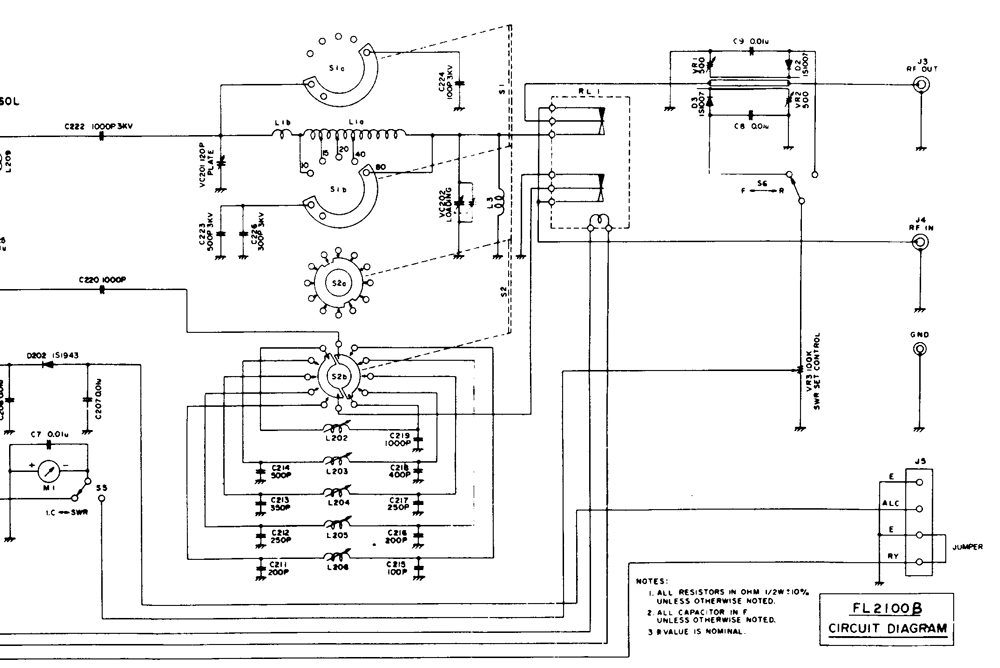
| C215 | C211,216 | C212,217 | C213 | C218 | C214 | C219 |
| 100 pF |
200 pF (180 or 220 pF OK) |
250 pF (220 or 270 pF OK) |
350 pF (330 or 360 pF OK) |
400 pF (390 pF OK) |
500 pF (470 or 510 pF OK) |
1000 pF |
Any silver mica
over 500 volts dc
rating is fine for
these capacitors. I
do not have any idea
why Yaesu used such
unreliable
high-voltage
capacitor. Voltage
across each
capacitor is only
150 volts peak.
Capacitors, if
both are changed on
any band, should be
resized in the same
direction for the
same band. In other
words if you
substitute a 270 pF
for C217, C213 (same
band) should be
subbed up to a 360
pF.
